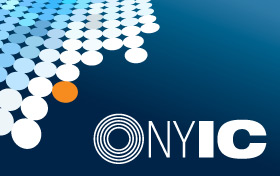Authors: Michael Cai, Marco Del Negro, Marc P. Giannoni, Abhi Gupta, Pearl Li, and Erica Moszkowski
-
- About the New York Fed
- What We Do
- Communities We Serve
-
More About Us
-
At the New York Fed, our mission is to make the U.S. economy stronger and the financial system more stable for all segments of society. We do this by executing monetary policy, providing financial services, supervising banks and conducting research and providing expertise on issues that impact the nation and communities we serve.

The New York Innovation Center bridges the worlds of finance, technology, and innovation and generates insights into high-value central bank-related opportunities.

Do you have a request for information and records? Learn how to submit it.

Learn about the history of the New York Fed and central banking in the United States through articles, speeches, photos and video.
-
- Markets & Policy Implementation
-
- Reference Rates
- Effective Federal Funds Rate
- Overnight Bank Funding Rate
- Secured Overnight Financing Rate
- SOFR Averages & Index
- Broad General Collateral Rate
- Tri-Party General Collateral Rate
- Desk Operations
- Treasury Securities
- Agency Mortgage-Backed Securities
- Repos
- Reverse Repos
- Securities Lending
- Central Bank Liquidity Swaps
- System Open Market Account Holdings
- Primary Dealer Statistics
- Historical Transaction Data
-
- Monetary Policy Implementation
- Treasury Securities
- Agency Mortgage-Backed Securities
- Agency Commercial Mortgage-Backed Securities
- Agency Debt Securities
- Repos & Reverse Repos
- Securities Lending
- Discount Window
- Treasury Debt Auctions & Buybacks
as Fiscal Agent - INTERNATIONAL MARKET OPERATIONS
- Foreign Exchange
- Foreign Reserves Management
- Central Bank Swap Arrangements
- ACROSS MARKETS
-
- Economic Research
- U.S. Economy
- Consumer Expectations & Behavior
- Growth & Inflation
- Economic Heterogeneity Indicators (EHIs)
- Multivariate Core Trend Inflation
- New York Fed DSGE Model
- New York Fed Staff Nowcast
- R-star: Natural Rate of Interest
- Labor Market
- Financial Stability
- Corporate Bond Market Distress Index
- Losses from Natural Disasters
- Outlook-at-Risk
- Treasury Term Premia
- Yield Curve as a Leading Indicator
- Banking
- RESEARCHERS
-
- Financial Institution Supervision
- Bank Applications
-
As part of our core mission, we supervise and regulate financial institutions in the Second District. Our primary objective is to maintain a safe and competitive U.S. and global banking system.

The Governance & Culture Reform hub is designed to foster discussion about corporate governance and the reform of culture and behavior in the financial services industry.

Need to file a report with the New York Fed? Here are all of the forms, instructions and other information related to regulatory and statistical reporting in one spot.

The New York Fed works to protect consumers as well as provides information and resources on how to avoid and report specific scams.
-
- Financial Services & Infrastructure
-
The Federal Reserve Bank of New York works to promote sound and well-functioning financial systems and markets through its provision of industry and payment services, advancement of infrastructure reform in key markets and training and educational support to international institutions.

The New York Innovation Center bridges the worlds of finance, technology, and innovation and generates insights into high-value central bank-related opportunities.

The growing role of nonbank financial institutions, or NBFIs, in U.S. financial markets is a transformational trend with implications for monetary policy and financial stability.

The New York Fed offers the Central Banking Seminar and several specialized courses for central bankers and financial supervisors.
-
- Community Development & Education
-
- Staff
-
Fed System Initiatives
- Other Community Development Work
- Calendar
-
March 2018 Revised September 2018
JEL classification: C11, C32, C54, E43, E44
The years following the Great Recession were challenging for forecasters. Unlike other deep downturns, this recession was not followed by a swift recovery, but generated a sizable and persistent output gap that was not accompanied by deflation as a traditional Phillips curve relationship would have predicted. Moreover, the zero lower bound and unconventional monetary policy generated an unprecedented policy environment. We document the real real-time forecasting performance of the New York Fed dynamic stochastic general equilibrium (DSGE) model during this period and explain the results using the pseudo real-time forecasting performance results from a battery of DSGE models. We find the New York Fed DSGE model's forecasting accuracy to be comparable to that of private forecasters and notably better, for output growth, than the median forecasts from the Federal Open Market Committee’s Summary of Economic Projections. The model’s financial frictions were key in obtaining these results, as they implied a slow recovery following the financial crisis.
The author declares that he has no relevant or material financial interests that relate to the research described in this paper, other than the fact that the author is an employee of the Federal Reserve Bank of New York.
Marco Del Negro
The author declares that he has no relevant or material financial interests that relate to the research described in this paper, other than the fact that the author is an employee of the Federal Reserve Bank of New York.
Marc P. Giannoni
The author declares that he has no relevant or material financial interests that relate to the research described in this paper, other than the fact that the author is an employee of the Federal Reserve Bank of Dallas and was an employee of the Federal Reserve Bank of New York while working on this project.
Abhi Gupta
The author declares that he has no relevant or material financial interests that relate to the research described in this paper, other than the fact that the author is an employee of the Federal Reserve Bank of New York.
Pearl Li
The author declares that he has no relevant or material financial interests that relate to the research described in this paper, other than the fact that the author is an employee of the Federal Reserve Bank of New York.
Erica Moszkowski
The author declares that she has no relevant or material financial interests that relate to the research described in this paper, other than the fact that the author was an employee of the Federal Reserve Bank of New York while working on this project.


